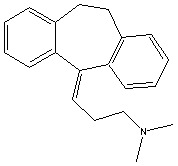Amitriptyline
Antidepressant with preference for norepinephrine transporter, but also block serotonin reuptake; high affinity in vitro for histamine H1 and muscarinic receptors C20H23N 50-48-6, 277.41 || Amitriptyline hydrochloride [549-18-8] C20H24ClN MW 313.9 Elavil
General
Type : Not A\/B H target,Muscarinic antagonist
Chemical_Nomenclature : 3-(10,11-dihydro-5H-dibenzo[a,d]cycloheptene-5-ylidene)-N,N-dimethyl-1-propanamine hydrochloride
Canonical SMILES : CN(C)CCC=C1C2=CC=CC=C2CCC3=CC=CC=C31.Cl
InChI : InChI=1S\/C20H23N.ClH\/c1-21(2)15-7-12-20-18-10-5-3-8-16(18)13-14-17-9-4-6-11-19(17)20\;\/h3-6,8-12H,7,13-15H2,1-2H3\;1H
InChIKey : KFYRPLNVJVHZGT-UHFFFAOYSA-N
Other name(s) : Emitrip,Endep,Enovil,Elavil hydrochloride,Amitid,Amitril,Deprex,Domical,Euplit,Lentizol,Miketorin,Saroten,Sylvemid,Tryptizol,Theda-T,Adepril,Amineurin,Laroxyl,Redomex,Sarotex,Tryptanol,Triptizol
MW : 277.4
Formula : C20H23N.HCl
CAS_number : 549-18-8
PubChem : 11065
UniChem : KFYRPLNVJVHZGT-UHFFFAOYSA-N
IUPHAR :
Wikipedia : Amitriptyline

Target
References (6)
| Title : In vitro effect of central nervous system active drugs on the ATPase- ADPase activity and acetylcholinesterase activity from cerebral cortex of adult rats - Barcellos_1998_Gen.Pharmacol_31_563 |
| Author(s) : Barcellos CK , Schetinger MR , Dias RD , Sarkis JJ |
| Ref : General Pharmacology , 31 :563 , 1998 |
| Abstract : Barcellos_1998_Gen.Pharmacol_31_563 |
| ESTHER : Barcellos_1998_Gen.Pharmacol_31_563 |
| PubMedSearch : Barcellos_1998_Gen.Pharmacol_31_563 |
| PubMedID: 9792215 |
| Title : Amitriptyline: a potent inhibitor of butyrylcholinesterase from human serum - Cokugras_1997_Gen.Pharmacol_29_835 |
| Author(s) : Cokugras AN , Tezcan EF |
| Ref : General Pharmacology , 29 :835 , 1997 |
| Abstract : Cokugras_1997_Gen.Pharmacol_29_835 |
| ESTHER : Cokugras_1997_Gen.Pharmacol_29_835 |
| PubMedSearch : Cokugras_1997_Gen.Pharmacol_29_835 |
| PubMedID: 9347335 |
| Title : Prevention of amitriptyline-induced avoidance impairment by tacrine in mice - Pavone_1997_Behav.Brain.Res_89_229 |
| Author(s) : Pavone F , Battaglia M , Sansone M |
| Ref : Behavioural Brain Research , 89 :229 , 1997 |
| Abstract : Pavone_1997_Behav.Brain.Res_89_229 |
| ESTHER : Pavone_1997_Behav.Brain.Res_89_229 |
| PubMedSearch : Pavone_1997_Behav.Brain.Res_89_229 |
| PubMedID: 9475630 |
| Title : [The toxicological characteristics of the interaction of cholinolytics with aminostigmine--a new reversible cholinesterase inhibitor]. [Russian] - Prozorovskii_1995_Eksp.Klin.Farmakol_58_57 |
| Author(s) : Prozorovskii VB , Sazonova AV |
| Ref : Eksperimentalnaia i Klinicheskaia Farmakologiia , 58 :57 , 1995 |
| Abstract : Prozorovskii_1995_Eksp.Klin.Farmakol_58_57 |
| ESTHER : Prozorovskii_1995_Eksp.Klin.Farmakol_58_57 |
| PubMedSearch : Prozorovskii_1995_Eksp.Klin.Farmakol_58_57 |
| PubMedID: 8704593 |
| Title : Effect of YM796, a novel muscarinic agonist, on the impairment of passive avoidance response in senescence-accelerated mice - Suzuki_1995_Pharmacol.Biochem.Behav_51_623 |
| Author(s) : Suzuki M , Yamaguchi T , Ozawa Y , Iwai A , Yamamoto M |
| Ref : Pharmacology, Biochemistry & Behavior , 51 :623 , 1995 |
| Abstract : Suzuki_1995_Pharmacol.Biochem.Behav_51_623 |
| ESTHER : Suzuki_1995_Pharmacol.Biochem.Behav_51_623 |
| PubMedSearch : Suzuki_1995_Pharmacol.Biochem.Behav_51_623 |
| PubMedID: 7675834 |
| Title : Comparative effects of chronic administration of some psychotropic drugs on rat brain cortex acetylcholinesterase activity - Bekpinar_1994_Prog.Neuropsychopharmacol.Biol.Psychiatry_18_555 |
| Author(s) : Bekpinar S , Oner P , Eryurek FG |
| Ref : Prog Neuropsychopharmacol Biological Psychiatry , 18 :555 , 1994 |
| Abstract : Bekpinar_1994_Prog.Neuropsychopharmacol.Biol.Psychiatry_18_555 |
| ESTHER : Bekpinar_1994_Prog.Neuropsychopharmacol.Biol.Psychiatry_18_555 |
| PubMedSearch : Bekpinar_1994_Prog.Neuropsychopharmacol.Biol.Psychiatry_18_555 |
| PubMedID: 8078989 |